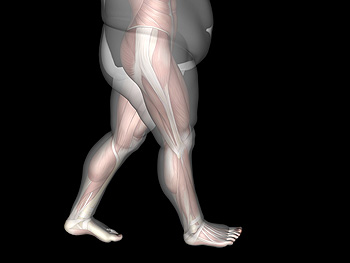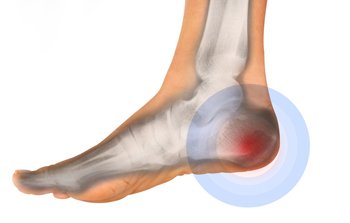December 2018
Walking Barefoot May Be Beneficial to Your Child’s Feet
 When babies are born, the tendons, joints, and bones are flexible, and this will typically result in children having flat feet until they are older. It may be beneficial to periodically have your child’s feet checked, which may ensure they are developing correctly. Research has shown the foot is comprised of 26 bones and that walking barefoot may aid in the proper development of strong bones and muscles. Wearing socks are beneficial in keeping the feet warm, and a good fit occurs when the socks are one quarter of an inch longer than the biggest toe. The importance of choosing the right size shoe is crucial in possibly preventing uncomfortable foot conditions from developing. It may be helpful to know that a sturdy shoe may be the best choice for this early stage of foot development, in addition to choosing leather soles, which may aid in traction. If you would like additional information about other forms of maintaining good foot health for your child, it is advised to speak with a podiatrist.
When babies are born, the tendons, joints, and bones are flexible, and this will typically result in children having flat feet until they are older. It may be beneficial to periodically have your child’s feet checked, which may ensure they are developing correctly. Research has shown the foot is comprised of 26 bones and that walking barefoot may aid in the proper development of strong bones and muscles. Wearing socks are beneficial in keeping the feet warm, and a good fit occurs when the socks are one quarter of an inch longer than the biggest toe. The importance of choosing the right size shoe is crucial in possibly preventing uncomfortable foot conditions from developing. It may be helpful to know that a sturdy shoe may be the best choice for this early stage of foot development, in addition to choosing leather soles, which may aid in traction. If you would like additional information about other forms of maintaining good foot health for your child, it is advised to speak with a podiatrist.
The health of a child’s feet is vital to their overall well-being. If you have any questions regarding foot health, contact Dr. Robert Graser of Graser Podiatry and Bunion Surgery Institute. Our doctor can provide the care you need to keep you pain-free and on your feet.
Tips for Keeping Children's Feet Healthy
- Make sure their shoes fit properly
- Look for any signs of in-toeing or out-toeing
- Check to see if they have Clubfoot (condition that affects your child’s foot and ankle, twisting the heel and toes inward) which is one of the most common nonmajor birth defects.
- Lightly cover your baby’s feet (Tight covers may keep your baby from moving their feet freely, and could prevent normal development)
- Allow your toddler to go shoeless (Shoes can be restricting for a young child’s foot)
- Cut toenails straight across to avoid ingrown toenails
- Keep your child’s foot clean and dry
- Cover cuts and scrapes. Wash any scratches with soap and water and cover them with a bandage until they’ve healed.
If you have any questions, please feel free to contact our office located in Boerne, . We offer the newest diagnostic and treatment technologies for all your foot care needs.
Flatter Arches May Be Indicative of Excess Weight Gain
 The feet bear the weight of the body. Uncomfortable and painful foot conditions may develop as a result of excess weight that is carried around. Many patients may find difficulty in maintaining a regular exercise program; this difficulty may be instrumental in gaining additional weight. This may be due to experiencing limited mobility, and losing the excess weight may prove to be challenging. The feet may change sizes, and you may notice the arch appearing flatter, in addition to the feet becoming wider. Some patients are familiar with arthritis that develops in the feet and ankles, which may be a side effect of increased weight gain. A specific type of arthritis that is known as gout may develop on the side of the big toe, which may be a result of ingesting unhealthy and fattening foods. If you have gained weight and are concerned about the health of your feet, it is suggested to speak with a podiatrist who can provide you with proper information.
The feet bear the weight of the body. Uncomfortable and painful foot conditions may develop as a result of excess weight that is carried around. Many patients may find difficulty in maintaining a regular exercise program; this difficulty may be instrumental in gaining additional weight. This may be due to experiencing limited mobility, and losing the excess weight may prove to be challenging. The feet may change sizes, and you may notice the arch appearing flatter, in addition to the feet becoming wider. Some patients are familiar with arthritis that develops in the feet and ankles, which may be a side effect of increased weight gain. A specific type of arthritis that is known as gout may develop on the side of the big toe, which may be a result of ingesting unhealthy and fattening foods. If you have gained weight and are concerned about the health of your feet, it is suggested to speak with a podiatrist who can provide you with proper information.
Obesity has become very problematic at this point in time and can have extremely negative effects on the feet. If you’re an obese individual and are concerned about your feet, contact Dr. Robert Graser from Graser Podiatry and Bunion Surgery Institute. Our doctor can provide the care you need to keep you pain-free and on your feet.
Obesity and Your Feet
Since your feet are what support your entire weight when standing, any additional weight can result in pain and swelling. Being overweight is one of the main contributors to foot complications.
Problems & Complications
Extra Weight – Even putting on just a few extra pounds could create serious complications for your feet. As your weight increases, your balance and body will shift, creating new stresses on your feet. This uneven weight distribution can cause pain, even while doing the simplest tasks, such as walking.
Diabetes – People who are overweight are at serious risk of developing type-2 diabetes, which has a drastic impact on the health of your feet. As you get older, your diabetes might worsen, which could lead to loss of feeling in your feet, sores, and bruises. You could also become more prone to various infections.
Plantar fasciitis – Pressure and stress that is placed on muscles, joints, and tendons can trigger plantar fasciitis, which is an inflammation of tissue that forms along the bottom of the foot.
If you have any questions please feel free to contact our office located in Boerne, . We offer the newest diagnostic and treatment technologies for all your foot and ankle needs.
How to Determine if You Have Endured a Stress Fracture
 Stress fractures are described as small cracks in the bone, which may be a result of repeated stress from running and jumping activities that are frequently performed. Proper treatment may generally include adequate resting time that is needed to heal this ailment, which may aid in preventing serious conditions from occurring to the bones in the feet. A proper diagnosis will typically include having an X-ray performed. If this is inconclusive, having an MRI taken may prove to be a more reliable method to determine if a stress fracture has occurred. Research has shown there may be ways that stress fractures may be prevented, and these may include maintaining overall strength in the bones. This may be accomplished by ingesting specific nutrients on a frequent basis. Additionally, when certain stretching exercises are performed before any running or jumping activities are pursued, the calf muscles may become looser. This may result in changing the running technique, which may change the amount of force the foot may endure. If you have developed a stress fracture in your foot, it is suggested to speak with a podiatrist, so a proper diagnosis can be performed.
Stress fractures are described as small cracks in the bone, which may be a result of repeated stress from running and jumping activities that are frequently performed. Proper treatment may generally include adequate resting time that is needed to heal this ailment, which may aid in preventing serious conditions from occurring to the bones in the feet. A proper diagnosis will typically include having an X-ray performed. If this is inconclusive, having an MRI taken may prove to be a more reliable method to determine if a stress fracture has occurred. Research has shown there may be ways that stress fractures may be prevented, and these may include maintaining overall strength in the bones. This may be accomplished by ingesting specific nutrients on a frequent basis. Additionally, when certain stretching exercises are performed before any running or jumping activities are pursued, the calf muscles may become looser. This may result in changing the running technique, which may change the amount of force the foot may endure. If you have developed a stress fracture in your foot, it is suggested to speak with a podiatrist, so a proper diagnosis can be performed.
Stress fractures occur when there is a tiny crack within a bone. To learn more, contact Dr. Robert Graser from Graser Podiatry and Bunion Surgery Institute. Our doctor can provide the care you need to keep you pain free and on your feet.
How Are They Caused?
Stress fractures are the result of repetitive force being placed on the bone. Since the lower leg and feet often carry most of the body’s weight, stress fractures are likely to occur in these areas. If you rush into a new exercise, you are more likely to develop a stress fracture since you are starting too much, too soon. Pain resulting from stress fractures may go unnoticed at first, however it may start to worsen over time.
Risk Factors
- Gender – They are more commonly found in women compared to men.
- Foot Problems – People with unusual arches in their feet are more likely to develop stress fractures.
- Certain Sports – Dancers, gymnasts, tennis players, runners, and basketball players are more likely to develop stress fractures.
- Lack of Nutrients – A lack of vitamin D and calcium may weaken the bones and make you more prone to stress fractures
- Weak Bones – Osteoporosis can weaken the bones therefore resulting in stress fractures
Stress fractures do not always heal properly, so it is important that you seek help from a podiatrist if you suspect you may have one. Ignoring your stress fracture may cause it to worsen, and you may develop chronic pain as well as additional fractures.
If you have any questions, please feel free to contact our office located in Boerne, . We offer the newest diagnostic and treatment technologies for all your foot care needs.
How to Diagnosis Plantar Fasciitis
 Many people who have heel pain are often diagnosed with a condition that is known as plantar fasciitis. The plantar fascia is the name of the tissue that runs along the bottom of the foot, which connects the heel bone to the toes. If this should become inflamed, plantar fasciitis may most likely develop. A proper examination is typically conducted to determine if this condition exists and this may include paying close attention to the arches of the foot, which may be exceptionally high, and pressing on the heel, which can pinpoint where the pain is originating from. Most patients who are afflicted with plantar fasciitis may experience heel pain as the first steps are taken in the morning. Additionally, if exercising is part of a daily routine, heel pain may be noticed after the workout is completed. Research has shown that recent lifestyle changes may play a significant role in developing this condition, which may include starting a new job, or spending extended periods of time walking or standing. This may be a result of the plantar fascia moving out of proper alignment. If you have heel pain, please consult with a podiatrist, so a proper diagnosis can be performed, and the correct treatment can begin.
Many people who have heel pain are often diagnosed with a condition that is known as plantar fasciitis. The plantar fascia is the name of the tissue that runs along the bottom of the foot, which connects the heel bone to the toes. If this should become inflamed, plantar fasciitis may most likely develop. A proper examination is typically conducted to determine if this condition exists and this may include paying close attention to the arches of the foot, which may be exceptionally high, and pressing on the heel, which can pinpoint where the pain is originating from. Most patients who are afflicted with plantar fasciitis may experience heel pain as the first steps are taken in the morning. Additionally, if exercising is part of a daily routine, heel pain may be noticed after the workout is completed. Research has shown that recent lifestyle changes may play a significant role in developing this condition, which may include starting a new job, or spending extended periods of time walking or standing. This may be a result of the plantar fascia moving out of proper alignment. If you have heel pain, please consult with a podiatrist, so a proper diagnosis can be performed, and the correct treatment can begin.
Plantar fasciitis can be very painful and inconvenient. If you are experiencing heel pain or symptoms of plantar fasciitis, contact Dr. Robert Graser from Graser Podiatry and Bunion Surgery Institute. Our doctor can provide the care you need to keep you pain-free and on your feet.
What Is Plantar Fasciitis?
Plantar fasciitis is the inflammation of the thick band of tissue that runs along the bottom of your foot, known as the plantar fascia, and causes mild to severe heel pain.
What Causes Plantar Fasciitis?
- Excessive running
- Non-supportive shoes
- Overpronation
- Repeated stretching and tearing of the plantar fascia
How Can It Be Treated?
- Conservative measures – anti-inflammatories, ice packs, stretching exercises, physical therapy, orthotic devices
- Shockwave therapy – sound waves are sent to the affected area to facilitate healing and are usually used for chronic cases of plantar fasciitis
- Surgery – usually only used as a last resort when all else fails. The plantar fascia can be surgically detached from the heel
While very treatable, plantar fasciitis is definitely not something that should be ignored. Especially in severe cases, speaking to your doctor right away is highly recommended to avoid complications and severe heel pain. Your podiatrist can work with you to provide the appropriate treatment options tailored to your condition.
If you have any questions please feel free to contact our office located in Boerne, . We offer the newest diagnostic and treatment technologies for all your foot and ankle needs.
Blog Archives
- July 2024
- June 2024
- May 2024
- April 2024
- March 2024
- February 2024
- January 2024
- December 2023
- November 2023
- October 2023
- September 2023
- August 2023
- July 2023
- June 2023
- May 2023
- April 2023
- March 2023
- February 2023
- January 2023
- December 2022
- November 2022
- October 2022
- September 2022
- August 2022
- July 2022
- June 2022
- May 2022
- April 2022
- March 2022
- February 2022
- January 2022
- December 2021
- November 2021
- October 2021
- September 2021
- August 2021
- July 2021
- June 2021
- May 2021
- April 2021
- March 2021
- February 2021
- January 2021
- December 2020
- November 2020
- October 2020
- September 2020
- August 2020
- July 2020
- June 2020
- May 2020
- April 2020
- March 2020
- February 2020
- January 2020
- December 2019
- November 2019
- October 2019
- September 2019
- August 2019
- July 2019
- June 2019
- May 2019
- April 2019
- March 2019
- February 2019
- January 2019
- December 2018
- November 2018
- October 2018
- September 2018
- August 2018
- July 2018
- June 2018
- May 2018








